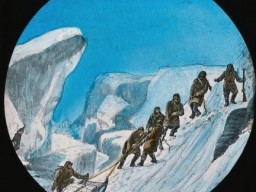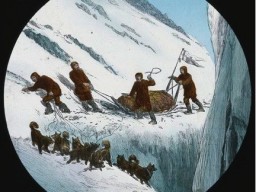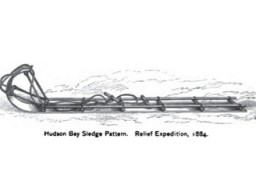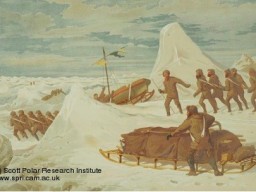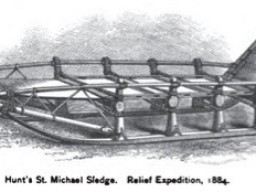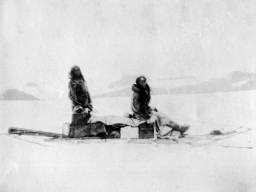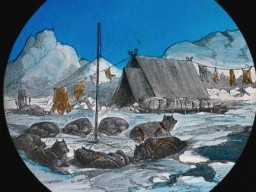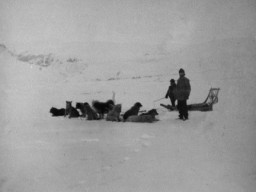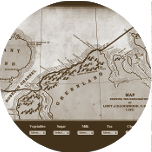Sledging the Arctic
Learn how to Play with this Interactive Exhibit
The Challenges of Arctic Sledging
 A sledging party hauls a heavily laden sled up a steep incline.
A sledging party hauls a heavily laden sled up a steep incline.
If you have ever dragged a toboggan laden with small children up a steep, snowy hill, then you have experienced only a mild version of the trials and tribulations of Arctic sledging, as practiced during the Heroic Age of Polar Exploration.
Surfaces
The Arctic Archipelago presents a diverse array of surfaces over which 19th century sledging parties laboured with heavy loads of food and equipment in their pursuit of new scientific and geographic discoveries. These surfaces include tundra, ice, snow, rivers and rock.
An ice foot is a wall or belt of ice frozen to the shoreline. Arctic sledging parties often preferred this route because of its comparatively smooth surface.
However, snow in coastal areas tended to be wet and deep, with an upper crust often not strong enough to support the weight of a man. If broken through, a sledger would find himself up to his knees in sugary snow, making walking almost impossible.
Ocean currents could also create great hummocks of ice that blocked the way forward. In response, men would use pick axes and shovels to hack their way through. Whether man-hauled or pulled by dogs, the journal entries made on sledging expeditions indicate that this was an exhausting and occasionally deadly task.
How Western Explorers and Inughuit used Sledges for Arctic Travel
What is a Sledge?
A sledge is a platform that rests upon a surface of ice or snow. The bottom of the sledge can either sit entirely on the surface, as with a toboggan, or be raised above it using runners. The advantage of a toboggan design is that it is very stable, which is an important consideration when hauling heavy loads over uneven terrain.
However, there is also greater friction because more surface area sits in contact with the ground. Using runners solves this problem by decreasing surface friction. These sledge runners were frequently shod with steel, which made them stronger and more durable.
Yet, because sleds on runners sit higher up, they tend to be unstable when hauling heavy loads over uneven terrain. Runners can also be easily damaged on rough surfaces, requiring their frequent repair or replacement during long sledge journeys.
 Men and dogs work together to move a heavy sled.
Men and dogs work together to move a heavy sled.
Evolution of Sledging Technology and Travel Strategies
The British Arctic Expedition (1875-76) used heavy sledges made from oak with iron-shod runners. Rather than rely solely on dogs, the members of sledging parties were harnessed eight men per sledge on different lengths of rope, to avoid colliding with one another while hauling.
When fully loaded with provisions, each sled weighed roughly 1400 lbs. (635 kg). In many ways, the sledges used by this expedition were treated almost like ships. Each one had a name and bore a standard with a pennant depicting a logo unique to each sledging crew. The main sledges were named Challenger and Victoria, while the three supporting sledges were called Poppie, Bulldog, and Alexandra. A small, four-man dog sled called Bloodhound was used for relaying messages, carrying sick or injured members of the expedition, and advanced scouting.
The Lady Franklin Bay Expedition (1881-84) used three distinctive types of sledge designs in their pursuits. The first had been recommended to Lieutenant Adolphus Greely by the venerable Arctic explorer Dr. John Rae. Known as the Hudson Bay Sledge Pattern, Captain William Kennedy had successfully used this design in his own expeditions.
Raised at a Hudson Bay Company Post at Cumberland House in Saskatchewan (then Rupert’s Land), John Rae was familiar with the cariole or “flat native sleighs” used by local First Nations. Rae modified this type of toboggan by adding iron-shod runners that were only a few inches high. The runners raised the sledge just high enough to reduce friction when running over ice, yet the sledge's lower profile allowed it to function as a toboggan in deeper snow.
The second type of sledge was the traditional eight-man sledge similar to those used by the British Arctic Expedition as well as those of Leopold McClintock – the acknowledged master of man-hauled sledging in the British Royal Navy.
The third type was a dog sled of Inughuit design, which featured “up standers” or “handle bars” rising up from the rear of the sledge that allowed the driver some limited steering ability. These sledges were reinforced using metal fasteners in place of sealskin or rope lashings, and with additional slats so they could better accommodate heavier loads.
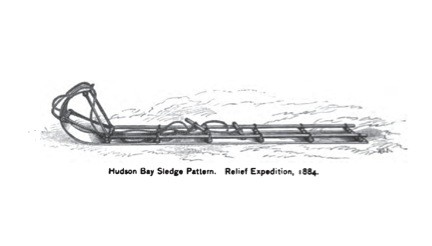 Illustration of a Hudson Bay sled used by the Lady Franklin Bay Expedition.
Illustration of a Hudson Bay sled used by the Lady Franklin Bay Expedition.
Greely learned a great deal about sledging from the bitter and sometimes tragic experiences of those who came before him. Extreme exhaustion caused by overladen sledges had resulted in illness among sledging crews. Recognizing the need to reduce weight wherever possible, Greely eliminated the shoeing of sledge runners with steel – something he would later regret, as the now unprotected ash runners were prone to breakage. He also expressed a preference for the lighter Hudson Bay sledges which, at a mere 35 lbs. (15.8 kg) each, were a third the weight of the larger British Navy sledges. Sergeant David Brainard actually measured the differences in travel times between Hudson Bay sledges and the larger British ones, finding the former to be much superior. Perhaps most importantly, Greely incorporated indigenous design elements into his own sledges. Thus began a trend that subsequent expeditions would expand. The ingenuity of sledge designs used by the Inuit of northern Canada had been recognized earlier by Leopold McClintock, who described an Inuit sled he encountered with runners made using seal skins that had been rolled up, flattened and allowed to freeze. The bottoms of these runners had then been covered with moss and ice, forming a smooth surface on snow. Greely himself commented on an abandoned Inuit sledge, likely of archaeological origin, found at Cape Baird on the shore of Lake Hazen.
Greely observed that the length of the sledge was much greater than those he planned to use. His own experiences later revealed that longer sledges performed better on rough rubble ice, and that they were inherently more stable with heavier loads. However, the light construction of these indigenous sledges relative to their British and American counterparts required that they be reinforced. This allowed them to carry loads heavier than any Inuit family would ever need to.
Decades later, American Polar Explorer Robert Peary, in his attempts to reach the North Pole, would take the use of indigenous sledging techniques in polar exploration to a new level by relying entirely on dog sleds driven by Inughuit mushers as his primary means of travel.
Man versus Dog
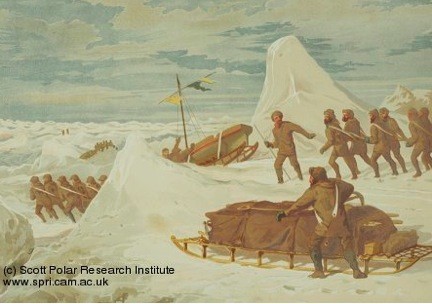 A sledging expedition from the British Arctic Expedition returns to their ship.
A sledging expedition from the British Arctic Expedition returns to their ship.
The British Navy expressed a marked preference towards man-hauling sledges rather than dog teams, as was the Inuit practice. Such an inclination is puzzling, given what humans (182lbs. or 82.5kg) versus dogs (100lbs or 45.3kg) can comfortably haul. Perhaps the penchant for man hauling was more a point of pride than one of practicality. Indeed, the Captain N.F Stephanson of the British Arctic Expedition wrote that:
The greatest enthusiasm exists on board about sledging and all think that if they do not have an opportunity, they will never be able to face their friends in England. I have promised each and all a belly full of it, and no doubt they will get it before we have done.
The naming of sledges and use of embroidered flags as standards suggest the appeal may relate to the competitive sportsman-like aesthetic that these sledging trips appear to have taken on. Popular Canadian historian Pierre Burton (1988:187) quipped that many British Naval Officers considered that “it was a form of cheating to use animals for transport” and that to the English “there was something noble and romantic about marching across the wastes, enduring incredible hardships with a smile on their face and a song in their hearts.”
Sadly, the sledging journeys completed by Lieutenant Pelham Aldrich and Commander A.H. Markham of the British Arctic Expedition turned out to be wretched lessons in endurance, hardship and exhaustion. Markham used four sledges – a twelve-man behemoth named Marco Polo, weighing 1,075kg, and three other eight-man sledges hauling an average of 1477lbs (670kg). This meant that each man dragged weights of around 230 lbs. (104.3kg)!
After a promising start over relatively smooth ice, the party became mired in deep snow. Jagged pressure ridges of ice and perpendicular drops between ice floes posed further challenges. Markham and Aldrich’s sledging parties rapidly began suffering from the effects of exhaustion. Scurvy soon added to their misery, requiring the use of the quicker and lighter dog sled to transport the infirm back to the expedition ships.
 Illustration of a typical Inuit sled design.
Illustration of a typical Inuit sled design.
The sledging journeys of the Lady Franklin Bay Expedition were similar to those of Markham and Aldrich in so much as they relied heavily (but not exclusively) on man hauling to achieve their objectives. Four sledges were used; Kane, Hayes, Hall, and Beaumont. Even though these sledges were of the lighter Hudson Bay type, their journeys were wrought with similar hardships. This is reflected in one of Brainard’s journal entries, in which he states:
Ralson, cook; temperature about -40° (-40° C); his duties were rendered very trying on account of having frozen his fingers during the operation of the morning meal. Our sleeping bags were like iron, and sleep was out of the question; our teeth were clattering and clashing together in the most dangerous manner. Connell froze one of his toes in his sleeping bag; it is very sore and considerably swollen, but he, however, intends to retain his place in the drag ropes. (Greely 1885:209).
Still, it is a misapprehension that British Naval expeditions did not make use of dog teams. As polar historian William Barr has pointed out, they were widely adopted during the search for the lost Franklin Expedition (1845-48). However, with a few exceptions, they were used mainly in supporting roles such as relaying messages between ships, transporting the sick and injured, hauling gravel for ship ballast, and conducting scientific work. American expeditions were somewhat of an exception. For example, the farthest north trip completed by Lieutenant James Booth Lockwood, Sergeant David Brainard, and Frederick Christensen was completed using a dog sled. In this instance, man-hauled sledges were used in a supporting role, laying depots and hauling supplies for the advance team. Decades later, Robert Peary would also make extensive use of “sledge trains” pulled by dog teams and driven by Inughuit guides, to move people and supplies over great distances. Peary recognized what many earlier explorers had not – that dogs worked tirelessly; were a workforce that could reproduce itself; and could be used as a source of food in times of need.
Nonetheless, dogs could also be causes of mischief, mayhem and trouble. By way of illustration, Brainard writes of his dogs that:
The thieving propensities of our canine friends were developed to an unusual degree. While we were sleeping they burst off the strings, entered the tent, and stole our provision bag and hare. They were so elated over the success of their raids that they forgot their caution and their retreat was not effected without considerable noise, which awoke us.
This was one of several humorous stories involving Ritenbenk, the lead sled dog of the team used by the men to better the farthest north record set previously by Commander Markham.
Another disadvantage of dogs involved a frequent and recurring problem that was often described as “fits.” Such medical issues were likely associated with diseases like canine rabies and distemper, and could result in large die-offs within a population of dogs. The ability to drive dog teams was also a special skill that few British Naval officers possessed. In the absence of these skills, one member of the party needed to run ahead of the team, which could be exhausting. Special hitches and harnesses were also required. It seems likely that dogs were hitched using the fan hitch, in which each dog is connected to the sledge via a line or “trace.” Rather than being of varying lengths, as with man-hauling arrangements, dog traces were of equal length except for that of the lead dog, which was slightly longer. Sourcing dogs could also be challenging. Luckily, expeditions to northeastern Ellesmere Island were able to purchase dogs from the settlements of northwest Greenland.
Sledging Strategies
Arctic sledging during the 19th and early 20th centuries required a great deal of planning. In many ways, the strategies used for long distance journeys were similar to those employed in mountaineering, in which a series of supply camps were established along the way to the summit. Similarly, a series of smaller sledging excursions were done before the main journey, to cache supplies at strategic locations along the trail. This served two purposes. First, it reduced the amount of food, fuel, medicine, and equipment that needed to be hauled by the main expedition party. Second, it provided a lifeline linking the sledging parties to supplies and medicines on the return trip that were often much needed. In the case of the Lady Franklin Bay Expedition, their “farthest north” attempt involved the four sledges Hayes, Kane, Hall, and Beaumont. They were hauled by ten men and were used to move supplies from Fort Conger to a series of depots along the trail. This was done in advance of the journey undertaken by Lockwood and his two companions by dog sled. When laying depots, snow houses were often used instead of tents, so as to maximize the consumables (food, fuel) being transported. Robert Peary used two mutually reinforcing strategies – travel by ship complemented by a sledge train of labour and supplies over the pack ice. Unlike earlier expeditions, Peary relied entirely upon Inughuit technology to transport labour and supplies. His sleds were indigenous in their design, using ivory from walrus tusks in place of iron for runner shoes. These sledges were short and light, making them fast on the trail but also prone to breakage. Field repairs were almost continuous while travelling.
List of Assets: From Scott Polar Research Institute and Greely’s “Three Years of Arctic Service”, as well as historic photos in possession of Parks Canada.


